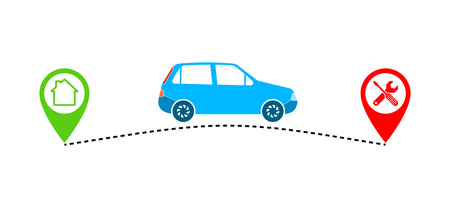1. Introduction to Engine Sensors
There’s something magical about the hum of a classic Chevy or the roar of a vintage Mustang. For generations, American cars have been more than just machines—they’ve been a way of life, each one telling its own story from Main Street to Route 66. But whether you’re behind the wheel of a ’60s muscle car or a modern pickup loaded with tech, there’s a hidden hero under the hood: engine sensors.
Back in the day, everything was mechanical—carburetors, distributors, and manual adjustments ruled the garage. Today, it’s all about sensors and electronics. Yet, these unsung components bridge the gap between old-school craftsmanship and modern reliability. Engine sensors may not get much glory at car shows, but they’re vital for keeping your ride running smooth, fuel-efficient, and ready for adventure.
Why Engine Sensors Matter in American Cars
From Detroit iron to today’s high-tech SUVs, engine sensors serve as the “nerves” of your vehicle. They pick up real-time information like temperature, air flow, and pressure, then feed it to the car’s computer so it can make split-second decisions. This ensures your engine delivers just the right mix of power and efficiency—whether you’re cruising down memory lane or tackling daily commutes.
Classic vs Modern: The Sensor Evolution
| Era | Main Components | Typical Sensors Used |
|---|---|---|
| Classic (Pre-1980s) | Carburetor, Mechanical Ignition | Few or None (Basic Temperature/Pressure Gauges) |
| Modern (1980s-Present) | Fuel Injection, Electronic Ignition | Oxygen Sensor, MAF Sensor, TPS, Coolant Temp Sensor, etc. |
The Heartbeat of Every American Ride
No matter if your pride and joy is a vintage cruiser or a cutting-edge family hauler, engine sensors are essential for performance and reliability. Understanding how they work—and what happens when they don’t—can save you time, money, and keep those wheels turning for years to come.
2. The Most Common Engine Sensors and What They Do
When it comes to keeping your car running like a champ, understanding the key engine sensors is a must. These small but mighty parts act like the car’s senses—telling the computer what’s happening under the hood so your ride runs smooth and efficient. Let’s break down some of the most common ones in plain, everyday American terms.
Oxygen Sensor (O2 Sensor)
The oxygen sensor sits in your exhaust system and keeps an eye on how much oxygen is in the exhaust gases. Basically, it helps the engine know if it’s burning too much or too little fuel. If this sensor goes bad, you might notice your gas mileage dropping or your check engine light popping on.
What It Does:
- Measures oxygen levels in the exhaust
- Tells the engine to adjust the fuel mix for cleaner emissions and better MPG
- Helps keep your catalytic converter happy
Mass Airflow Sensor (MAF Sensor)
This sensor is right behind your air filter and its job is to measure how much air is coming into your engine. More air means more power—but only if the engine knows about it! A dirty or faulty MAF sensor can make your car run rough or stall out at red lights.
What It Does:
- Measures how much air is entering the engine
- Helps balance air-to-fuel ratio for smooth performance
- Improves throttle response and acceleration
Crankshaft Position Sensor
This one’s a real workhorse—it keeps track of where your crankshaft is as it spins. That info tells your spark plugs when to fire, which keeps your engine running on time. If this sensor fails, you could have trouble starting up or experience random stalling.
What It Does:
- Monitors crankshaft position and speed
- Sends timing info to ignition and fuel systems
- Keeps engine firing at just the right moment
Sensors at a Glance
| Sensor Name | Main Job | Common Symptoms of Failure |
|---|---|---|
| Oxygen Sensor (O2) | Checks exhaust for oxygen levels | Poor gas mileage, rough idle, check engine light |
| Mass Airflow Sensor (MAF) | Measures incoming air volume | Engine stalling, hesitation, hard starts |
| Crankshaft Position Sensor | Keeps track of crankshaft rotation and timing | No-start condition, misfires, stalling out of nowhere |
The Takeaway on Engine Sensors
If you’re chasing down why your check engine light’s on or why your old faithful ride isn’t acting quite right, these sensors are a great place to start looking. Catching issues early can save you time, money, and maybe even keep you from getting stranded by the side of the road.

3. Signs Your Engine Sensors Are Failing
If you’ve spent enough time behind the wheel—whether cruising down Route 66 or just making your daily commute—you know your car will often “talk” to you when something’s off. Engine sensors are no different. When they start to fail, they send up warning flags that any classic car lover or modern driver should recognize. Let’s break down the telltale signs and real-life dashboard alerts that signal your engine sensors need attention.
Classic Symptoms You Can’t Ignore
| Symptom | What It Feels Like | Possible Sensor Involved |
|---|---|---|
| Rough Idling or Stalling | Your engine sputters or shuts off at stoplights | Mass Air Flow (MAF), Oxygen (O2) |
| Poor Gas Mileage | You’re filling up more often without a change in driving habits | Oxygen (O2), Coolant Temperature |
| Check Engine Light On | The infamous orange light pops up on your dash | Any major engine sensor |
| Hard Starting or No Start | You turn the key, but the engine cranks forever or not at all | Crankshaft Position, Camshaft Position, MAF |
| Lack of Power/Sluggish Acceleration | Your ride feels like it’s lost its pep on hills or passing lanes | Throttle Position, MAF, O2 |
| Black Smoke from Exhaust | You notice thick, dark smoke when accelerating or idling | O2, MAF, Fuel Temperature Sensor |
| Engine Hesitation or Surging | The engine jerks, hesitates, or revs unexpectedly while driving steady speeds | Throttle Position, O2, MAF |
Dashboard Warnings: The Car’s Way of Calling for Help
No matter if you’re driving a vintage Mustang or a late-model pickup, dashboard warning lights are your first sign of trouble. Here are some common alerts:
- Check Engine Light (CEL): This is the big one—if it flickers on and stays lit, a sensor is likely unhappy. Don’t ignore it!
- Service Engine Soon: Slightly less urgent than CEL but still means something isn’t right with a monitored system.
- Reduced Power/“Limp Mode”: Your car might limit speed and power to protect itself if it senses a critical failure.
- Temperature Gauge Swings: If your temp gauge starts acting wild, your coolant temp sensor may be on the fritz.
- ABS/Traction Control Lights: Sometimes engine sensor issues can trigger other systems’ warnings due to shared data signals.
A Real-World Story from Main Street USA:
Take Bob from Ohio—he noticed his trusty Chevy Silverado was drinking gas faster than usual and felt sluggish up steep grades. The check engine light came on during a weekend drive. At the shop, the culprit turned out to be a failing oxygen sensor—a classic case of a small part making a big impact.
Why Early Detection Matters:
Catching these symptoms early can save you money and prevent bigger headaches down the road. Trust what your dashboard—and your gut—are telling you. If something feels off, odds are one of those hardworking sensors is calling out for help.
4. DIY Diagnostics: How to Pinpoint the Problem
Theres nothing quite like rolling up your sleeves and getting under the hood with some classic American know-how. You dont need a fancy scan tool or a high-tech garage to figure out whats going on with your engine sensors. Here are some hands-on tips to help you hunt down those pesky sensor issues using simple tools that you probably already have in your toolbox.
Listen, Look, and Feel: Your First Line of Defense
Before you even pick up a wrench, start with your senses—just like folks did back in the day. Listen for rough idling or hesitation, look for warning lights on the dash, and feel for any odd vibrations or lack of power. Sometimes, these clues can point you straight to the troubled sensor.
The Classic Tools Youll Need
| Tool | Purpose |
|---|---|
| Screwdriver Set | Removing covers and connectors |
| Digital Multimeter | Testing voltage and resistance |
| Socket Set | Unbolting sensors and brackets |
| Shop Rag | Cleaning off dirt and grime |
| Service Manual (or online guide) | Reference wiring diagrams & specs |
Step-by-Step Troubleshooting Tips
- Visual Inspection: Pop the hood and check sensor wiring for cracks, corrosion, or loose connectors. Many times, a simple reconnect or cleaning fixes the problem.
- Check Engine Light Codes: If your dashboard is lit up, swing by an auto parts store—theyll usually read codes for free. Write down the code numbers; they often point to specific sensors.
- Multimeter Magic: Test sensor circuits for proper voltage and resistance as shown in your manual. Compare your readings to factory specs—off numbers mean trouble.
- Tug Test: Gently wiggle wires near sensors while the engines running. If it stumbles or stalls, youve found a bad connection.
- Swap and See: For some sensors (like MAP or MAF), if you have a buddy with the same ride, try swapping sensors briefly to see if symptoms follow.
Sensors Most Likely to Fail—and How to Check Them Fast
| Sensor Name | Quick Check Tip | Telltale Sign Its Bad |
|---|---|---|
| Oxygen (O2) Sensor | Poke harness with multimeter for voltage fluctuation while engine idles warm | Poor fuel economy, rough idle, failed emissions test |
| Mass Air Flow (MAF) Sensor | Tap gently while engine runs; stumble means dirty/bad MAF | Lack of power, hard starts, surging idle |
| Throttle Position Sensor (TPS) | Sweep throttle by hand; watch voltage climb smoothly on meter—no jumps allowed! | No acceleration response, hesitation off idle |
| Coolant Temp Sensor (CTS) | Cooled engine? Check resistance; compare to chart in service manual. | Poor cold starting, overheating warning when engines cold |
| Crankshaft/ Camshaft Position Sensor | No-start? Measure output signal while cranking—should pulse regularly. | No start or random stalling while driving |
A Final Word on Safety and Patience
Troubleshooting sensors is part science, part art. Take your time, work safely (disconnect that battery before unplugging electronics!), and trust your hands-on instincts. Sometimes it’s just a little bit of elbow grease that brings those old engines back to their prime.
5. Repair or Replace? Fixing Faulty Engine Sensors
How to Decide: Repair or Replace?
When an engine sensor goes bad, it can be tough to know whether you should try to fix it or just swap in a new one. For restoration buffs who cherish every original part, and for daily drivers who just want smooth rides, the choice can feel like a crossroads on Route 66. Here’s a practical guide to help you make the call.
Signs Your Sensor Needs Attention
- Check Engine Light: The classic warning sign.
- Poor Fuel Economy: More trips to the pump than usual.
- Rough Idling: The engine feels jumpy or uneven.
- Hard Starting: Trouble firing up in the morning.
- Failed Emissions Test: Trouble passing those smog checks.
Repair vs. Replace: A Quick Comparison
| Situation | Best Option | Why? |
|---|---|---|
| Minor wiring issue or connector corrosion | Repair | A little cleaning or rewiring may save the day and keep things original. |
| Sensor internals damaged or worn out | Replace | Sensors are delicate—once they go bad inside, replacement is safer and more reliable. |
| Noisy signal but sensor looks fine | Repair (sometimes) | If it’s just loose, re-seating might do the trick. Otherwise, replacement is easier. |
| Persistent trouble codes after repairs | Replace | If fixing wires doesn’t clear the code, swap out the sensor for peace of mind. |
| Restoration project with rare parts | Repair if possible | If originality matters and parts are hard to find, repair is worth a try first. |
Tips for Both Camps: Restorers & Daily Drivers
- Restoration Enthusiasts: Take your time with cleaning contacts and checking wiring harnesses before replacing vintage sensors. Sometimes all you need is some contact cleaner and patience!
- Everyday Drivers: If you’re short on time and need reliability, modern replacement sensors are often affordable and get you back on the road fast—no fuss, no muss.
The Tool Kit You’ll Need
- Screwdrivers (Phillips & flathead)
- DMM (Digital Multimeter) for testing voltage/resistance
- Contact cleaner spray
- Sockets and ratchets (for tight spaces)
- A steady hand and a bit of old-school patience!
No matter which route you take—preserving a piece of automotive history or keeping your commuter car humming—a little know-how goes a long way when dealing with engine sensors. Happy wrenching!
6. Preventive Care for Your Engine Sensors
If you love classic American cars or just want your daily driver to run smooth, preventive care for your engine sensors is a must. These little components are the unsung heroes under the hood—keeping your ride running strong and steady. Here’s how you can give them the old-school care they deserve, blending timeless maintenance habits with a few pro tips from seasoned mechanics.
Classic Sensor Maintenance Habits
- Keep It Clean: Dirt, oil, and road grime can mess with sensor readings. Wipe down connectors and sensor housings with a soft cloth during routine checks.
- Check Connections: Every oil change, give those sensor wires and plugs a quick look. Loose or corroded terminals are a common culprit for false readings.
- Avoid Moisture: Water and electronics don’t mix. Make sure grommets and seals around sensors are snug to keep moisture out, especially after driving through rain or snow.
- Respect the “Check Engine” Light: Don’t ignore warning lights on your dash. Modern engines are smart—they’ll let you know when something’s off with a sensor before it becomes a big headache.
Pro Tips from American Garage Legends
| Pro Tip | How It Helps |
|---|---|
| Use Dielectric Grease on Connectors | Prevents corrosion and ensures solid electrical contact—just like the pros do in Midwest winters. |
| Replace Air Filters Regularly | Keeps mass airflow sensors clean, ensuring better fuel efficiency and smoother performance. |
| Schedule Sensor Checks with Tune-Ups | Makes it easy to catch issues early, just like the service stations did back in the day. |
| Avoid Aftermarket Shortcuts | Stick to OEM-quality sensors and parts for reliability—American classics deserve no less! |
Signs Your Sensors Need Attention
- Poor gas mileage—could be an oxygen or MAF sensor acting up.
- Rough idling or hesitation during acceleration—often linked to throttle position or coolant sensors.
- Difficult starts or stalling at stops—a crankshaft or camshaft sensor might be sending mixed signals.
The Spirit of American Motoring Lives On
Caring for engine sensors isn’t just about avoiding breakdowns—it’s about keeping that all-American tradition of hands-on car care alive. Whether you’re wrenching on a vintage muscle car or keeping your trusty pickup purring, these classic habits ensure your engine—and your adventures—keep rolling strong for miles to come.
7. When to Call in the Pros
There’s a certain pride that comes with fixing things yourself—the smell of grease, the satisfaction of tightening that last bolt, and the sense of accomplishment you get when your engine purrs back to life. But even the most dedicated DIYers know there are times when it’s best to trust your local mechanic. Let’s take a nostalgic stroll through the classic signs that tell you when an engine sensor issue is a Saturday afternoon project, and when it’s time to preserve the hometown garage tradition by handing it over to the pros.
DIY or Mechanic? Classic Signs to Watch For
| Sensor Issue | DIY Friendly? | When to Call the Pros |
|---|---|---|
| Oxygen Sensor Replacement | Yes, if you have basic tools and access under your car | If bolts are rusted tight or wiring looks damaged |
| Mass Air Flow (MAF) Sensor Cleaning | Yes, cleaning is easy with MAF cleaner spray | If sensor needs replacement or error keeps coming back |
| Coolant Temperature Sensor Swap | Yes, usually simple on older models | If sensor location is hard to reach or coolant leaks appear |
| Crankshaft/Camshaft Position Sensors | No, often buried deep in modern engines | Always call the pros for diagnosis and replacement |
| Check Engine Light Won’t Turn Off | Try reading codes and resetting with an OBD-II scanner | If light returns or multiple codes appear—get expert help |
The Value of Your Local Garage Tradition
There’s something special about rolling up to a local shop where folks still remember your name—and maybe your granddad’s old Chevy. Mechanics aren’t just experts; they’re keepers of community knowledge and classic car wisdom. When a sensor problem feels out of your league, don’t sweat it. Handing off the job doesn’t mean giving up—it means keeping that time-honored garage spirit alive.
Trust Your Gut—and Your Mechanic!
If a repair starts feeling more like rocket science than good old-fashioned wrench-turning, it’s okay to step aside. Whether you’re tightening sensors at home or dropping by your favorite hometown garage, keeping your ride running smooth is what matters most.


